Editorial: Island Lady Fire Analyzed – Feature: Understanding and Preventing Aluminum Corrosion
Text and photos copyright © 2018 Steve D’Antonio Marine Consulting, Inc.
From the Masthead
With the fall boat show season in our wake, the Marine Systems Excellence eMagazine returns.
“At least 1 dead after Florida casino shuttle boat is consumed by flames”
That headline, and others like it were splashed across newspapers and TV stations in Florida and around the country roughly year ago. It represented a completely avoidable tragedy.
The Island Lady, a 24-year old, 72-foot long, wooden-hulled “T Boat”, a former whale watching excursion vessel, and now offshore casino ferry, caught fire in the waters of the Pithlachascotee River, near Port Ritchey, Florida on January 14, 2018.
Last week the NTSB (National Transportation Safety Board) released a synopsis of its full report and investigation of this episode. The document provides a glimpse into the events of that fateful winter afternoon off Florida’s West Coast.
The vessel left the dock with 53 people aboard, headed for a casino ship located nine miles offshore. Shortly after getting underway at 4:00 PM the captain received a jacket water overheat alarm for the port engine. He reversed course and headed back to the dock. Fatefully, rather than shutting the engine down, he instead chose to reduce rpm to idle speed; it continued to run, and continued to pump hot exhaust into the exhaust plumbing (diesel engine exhaust ranges from about 400° to 1,100° Fahrenheit). On the return journey smoke began to fill the lazarette, engine room and main deck. Ultimately the vessel was consumed by flames. The captain beached the vessel; passengers and crew jumped overboard and walked or swam ashore, there were several injuries, one woman died in the hospital form smoke inhalation. The vessel was a complete loss
What Happened and Why; What Can be Learned?
As the overheating engine idled, the now un-cooled dry exhaust system’s fiberglass tubing caught fire, and/or it caused surrounding timber to ignite.
The NTSB report includes a series of observations and recommendations, some of which are worth sharing.
- The captain was not trained by the vessel owner as to how he should deal with an overheat scenario. Many would say, “Isn’t that common sense? It was a twin-screw vessel, shut one engine down”. To an extent I’d agree, however, where shipboard emergencies are concerned little should be left to common sense, a procedure should be established, especially for scenarios as common as overheating. For more on overheat alarms see alarms
- There was no smoke detection capability in the lazarette. While this was not required on this vessel, the NTSB never the less believes it would have been beneficial, and I agree. Photoelectric smoke detectors should be located in all engineering spaces, engine rooms, lazarettes etc. For more on this see smoke
- The NTSB believes the lack of a preventive maintenance program contributed to the overheating. Without more information I’m not sure how that can be ascertained. If, for instance, the impellers had not been replaced within the required replacement interval then a maintenance failure may have been the culprit, otherwise trash sucked into the intake could just as easily have caused the failure. For more on raw water pump maintenance see pumps
- Perhaps most important of all is a citation by the NTSB of the Code of Federal Regulations (CFR) where fuel systems are concerned. This section of the CFR, 46-182.440 (a)7 states, “…Tubular gauge glasses [sight glasses], if fitted to diesel fuel tanks, must be of heat resistant materials, adequately protected from mechanical damage, and provided at the tank connections with devices that will automatically close in the event of rupture of the gauge or gauge lines.” The report states that the sight glass material used aboard this vessel was plastic. Once the fire spread to the engine room, the diesel tank sight glasses melted, allowing the contents of the fuel tanks to flow into and feed the fire. The sight glasses were equipped with valves that did not automatically close. The report goes on to say that this fact was missed in the vessel’s coast guard inspection, stating, “During an inspection of the Island Lady before the fire, the Coast Guard did not correctly assess the fuel system’s compliance with applicable regulations.” For more on fuel system plumbing see Fuel System Plumbing Explained.
From a recreational vessel perspective, which is relevant to the bulk of the readers of this column, standards set forth by the American Boat and Yacht Council, section H-33, Diesel Fuel Systems, do not call for the use of heat resistant materials where sight glasses are concerned, however, they do clearly require users to keep sight glass valves closed other than when checking fuel levels. Readily available and inexpensive, spring-loaded auto-closing sight glass valves are a wise investment.
While this story is a gloomy one, there are clear lessons that apply to every powered vessel. In addition to those already mentioned, there’s one further worthwhile recommendation. Inboard-powered vessels should be equipped with wet exhaust high temperature alarms. These will typically sound within 30 seconds of a loss of cooling water, long before any damage is done to engines or exhaust components. Had this vessel been so equipped, it’s possible the alarm would have sounded before the Island Lady had slipped her lines. Wet exhaust tempera alarms are required for ABYC compliance.
The NTSB abstract can be accessed here.
This month’s Marine Systems Excellence eMagazine article covers the thorny subject of aluminum corrosion, detailing its most common causes, and preventive measures. I hope you find it both interesting and useful.
Understanding and Preventing Aluminum Corrosion
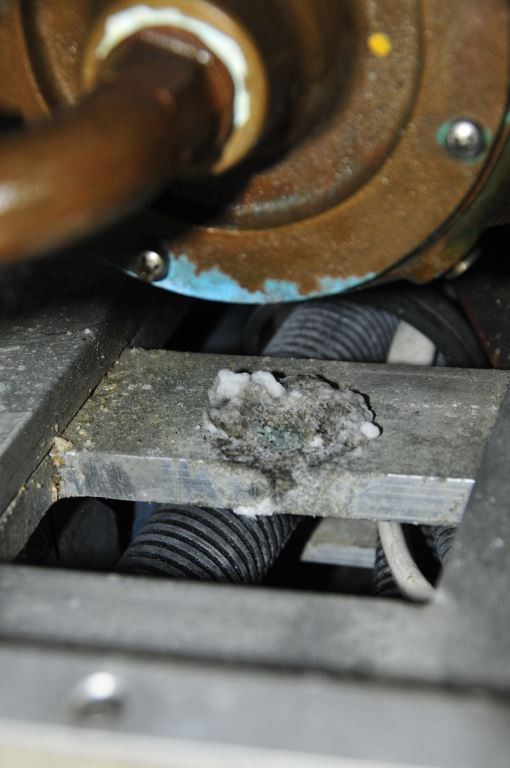
This bronze pump, leaking onto its aluminum base plate, caused the latter to corrode. The leaking water carried with it salts of copper, which were all that was needed to cause galvanic corrosion.
In the world of corrosion there exists a list or chart, called the galvanic series; it organizes metals from most noble, and most corrosion resistant or cathodic, to least noble, and least corrosion resistant, or anodic. Depending on the source, the series may be organized with cathodic metals at the top or bottom, however, the version included in the American Boat and Yacht Council’s Standards establishes the most cathodic metals at the bottom, where the kings of corrosion resistance, graphite, platinum and titanium, among others, reside. At the top end of the series the most corrosion-prone metals, magnesium, zinc and aluminum, will be found.
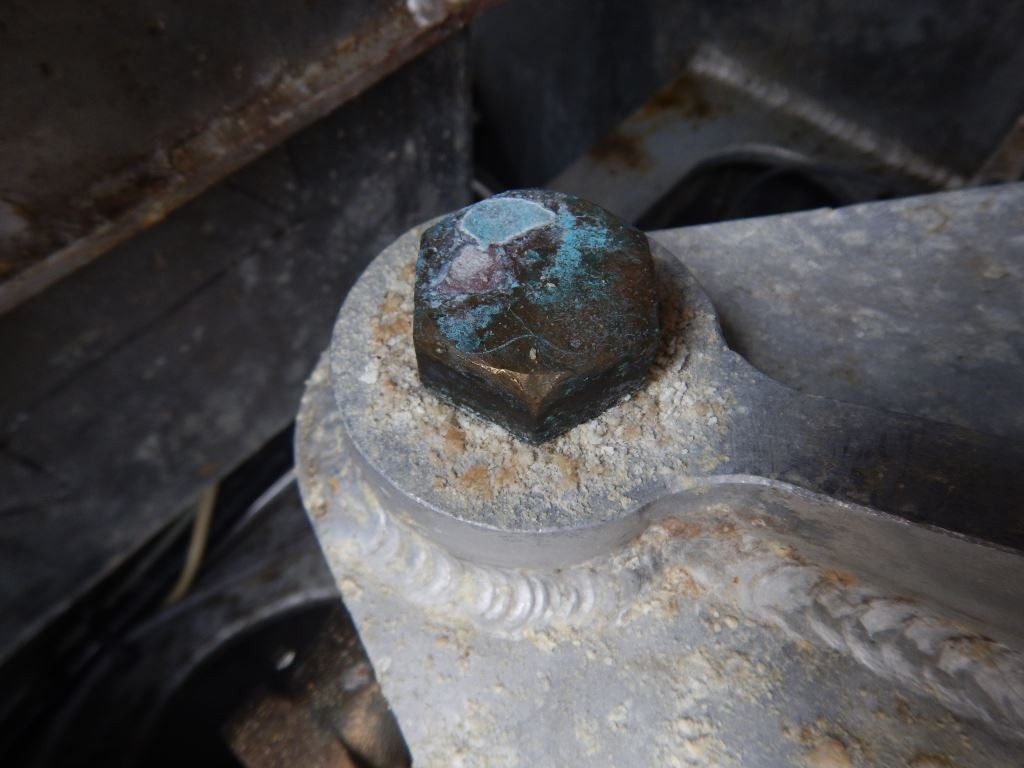
A bronze bolt used in an aluminum steering quadrant, with corrosion byproduct. A stainless steel bolt should have been used in this application.
Indeed, it comes as a surprise to many to learn that aluminum is among the most corrosion-prone metals. This may seem counter-intuitive in that aluminum is ubiquitous in the world of boat building, being used for everything from spars and outboards, to deck hardware, and of course complete vessels. In fact, it’s also used as a sacrificial anode, which is telling. Aluminum, of which there are many alloys, is a metal of many contradictions.
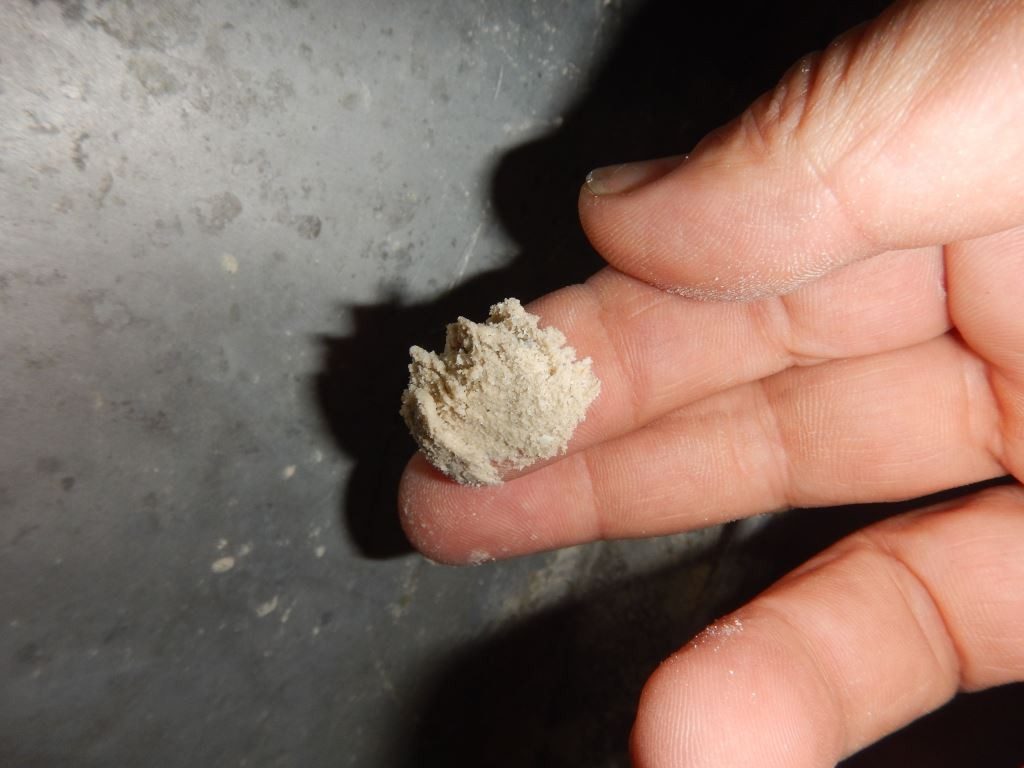
Sand in the bilge of an aluminum hull; anything that retains water against aluminum is considered a poultice corrosion risk. All bilges should be kept clean, and especially those of aluminum vessels.
Aluminum most commonly falls prey to two types of corrosion, galvanic and poultice. Galvanic corrosion occurs when aluminum is placed in contact with another metal, establishing a galvanic cell, either directly or via a wire or other electrical connection, with both being immersed in an electrolyte. That’s straightforward enough, however, a host of details are worthy of discussion in order to understand how this works. Perhaps most importantly, virtually every other metal, save two, zinc and magnesium, is nobler than aluminum, and as such they all will cause aluminum to corrode at varying rates when the two are in contact.
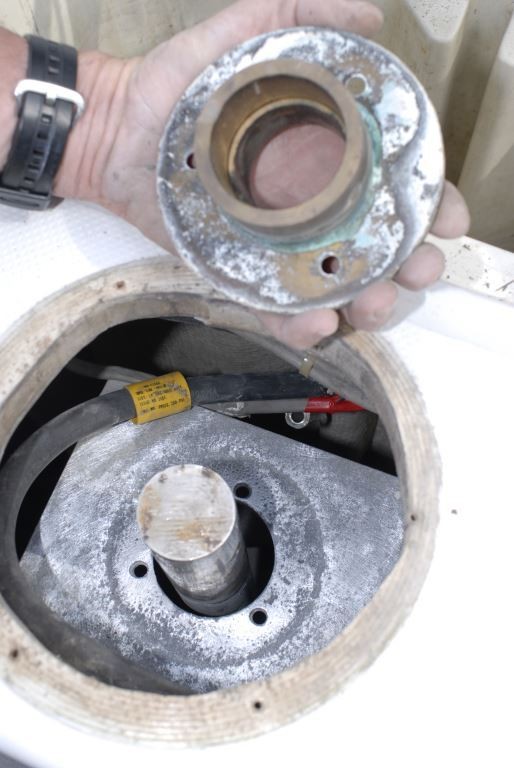
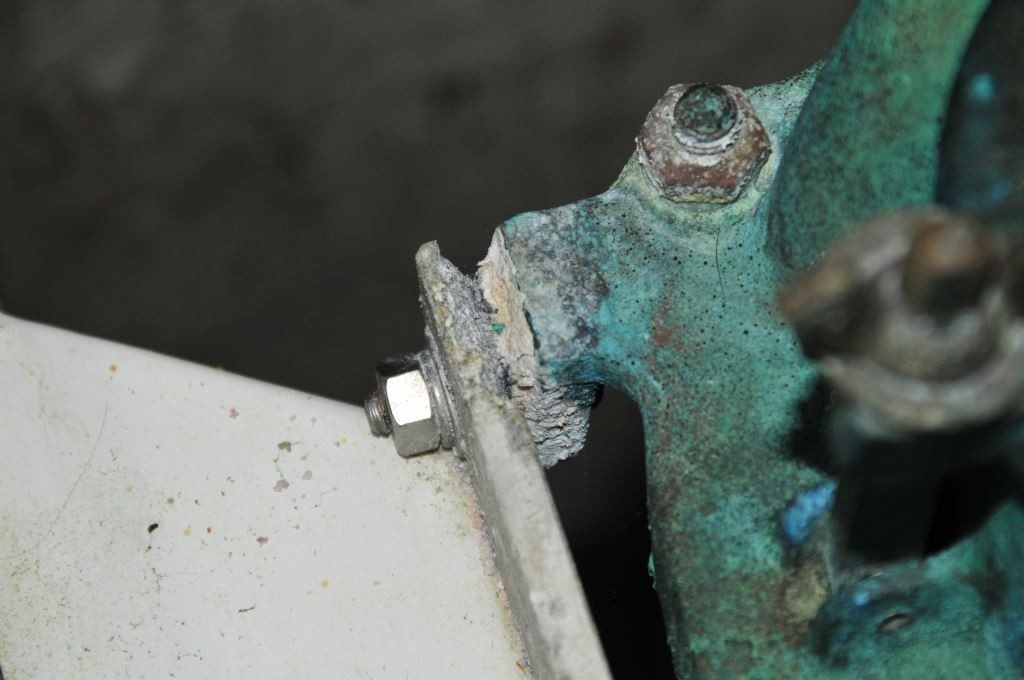
Among the most common corrosion scenarios, copper and aluminum alloys in direct contact, in a moist environment. Being much less noble, the aluminum suffers the consequences.
The further the other metal is away from aluminum on the galvanic series, the more rapidly the aluminum will corrode. Therefore, while stainless steel will cause aluminum to corrode when the two are in contact under these conditions, the rate is not especially quick, and as such the two are considered moderately compatible. Copper and copper alloys, on the other hand, including brass and bronze, are located further away from aluminum in the series, and are therefore far more harmful; they are considered entirely incompatible with aluminum. A bronze pump t, for instance, mounted directly to an aluminum base plate, would be considered a serious corrosion faux pas.
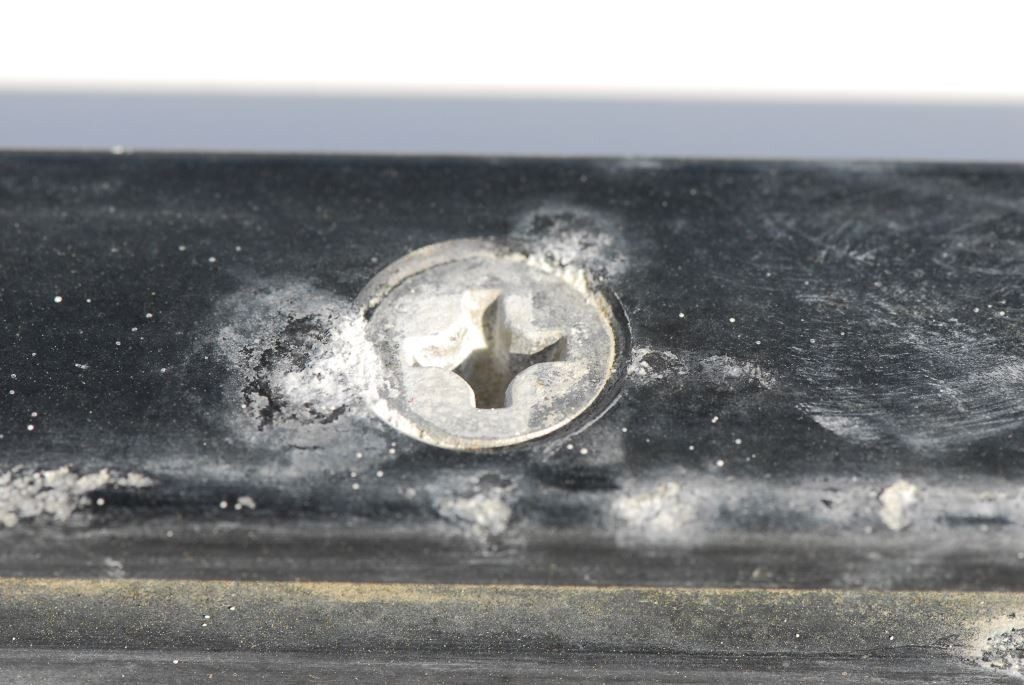
While stainless steel and aluminum are considered moderately compatible, given enough time in contact and wet, the aluminum will suffer. Thoroughly bedding this fastener would have at least slowed this corrosion cell.
The “electrolyte” is typically seawater, however, freshwater will also allow the reaction to occur, albeit it at a slower pace. Furthermore, while immersion in the electrolyte completes the galvanic cell, it’s not essential; exposure to simple atmospheric humidity, spray or rain will suffice, once again at a slower pace. Galvanic corrosion can be prevented in one of two ways, by isolating aluminum from incompatible metals, and/or by the use of sacrificial anodes, and the latter only in the case of submerged metals.
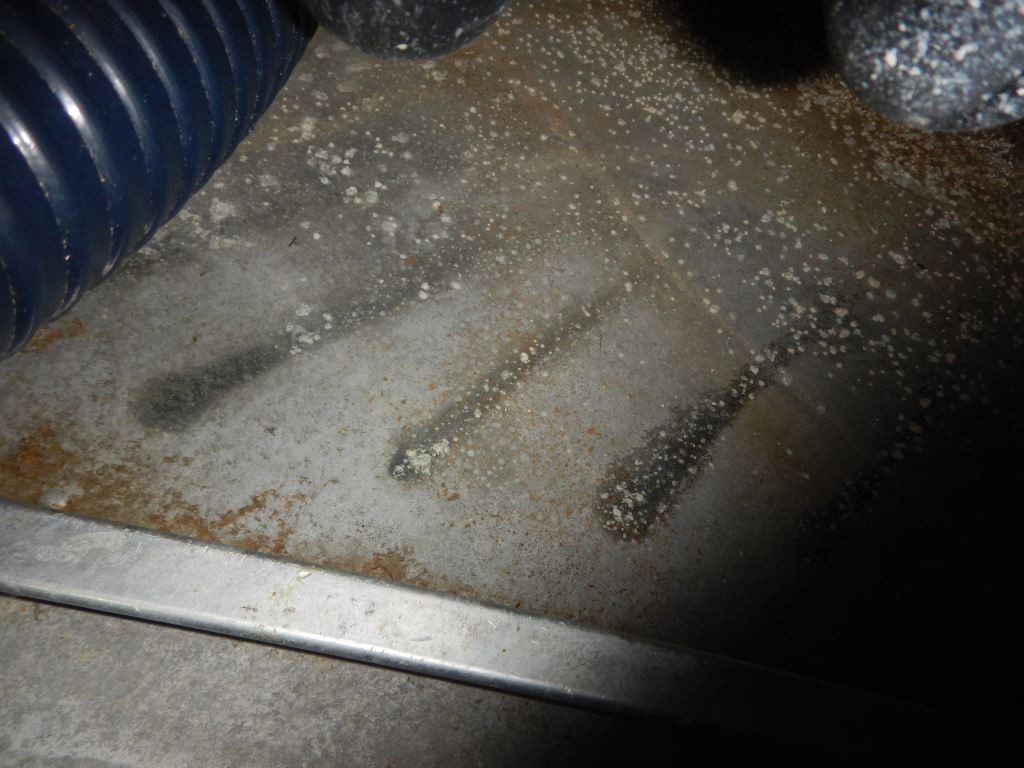
Aluminum hull corrosion, the result of water dripping from a bronze raw water plumbing manifold.
The other malady to which aluminum is susceptible is poultice corrosion. This is referred to as ‘simple corrosion’, in that no other metals are involved. When exposed to air, aluminum almost instantly develops a tough transparent coating which serves as a corrosion inhibitor. Even underwater, provided it’s not stagnant, aluminum is exposed to enough dissolved oxygen for this coating to form. If aluminum is starved of oxygen, however, and it remains exposed to moisture, the environment becomes ideal for the formation of poultice corrosion. Because the oxide coating cannot form without oxygen, the aluminum becomes active; it corrodes, and in the process forms a white byproduct called aluminum hydroxide, which resembles freezer-burned vanilla ice cream.
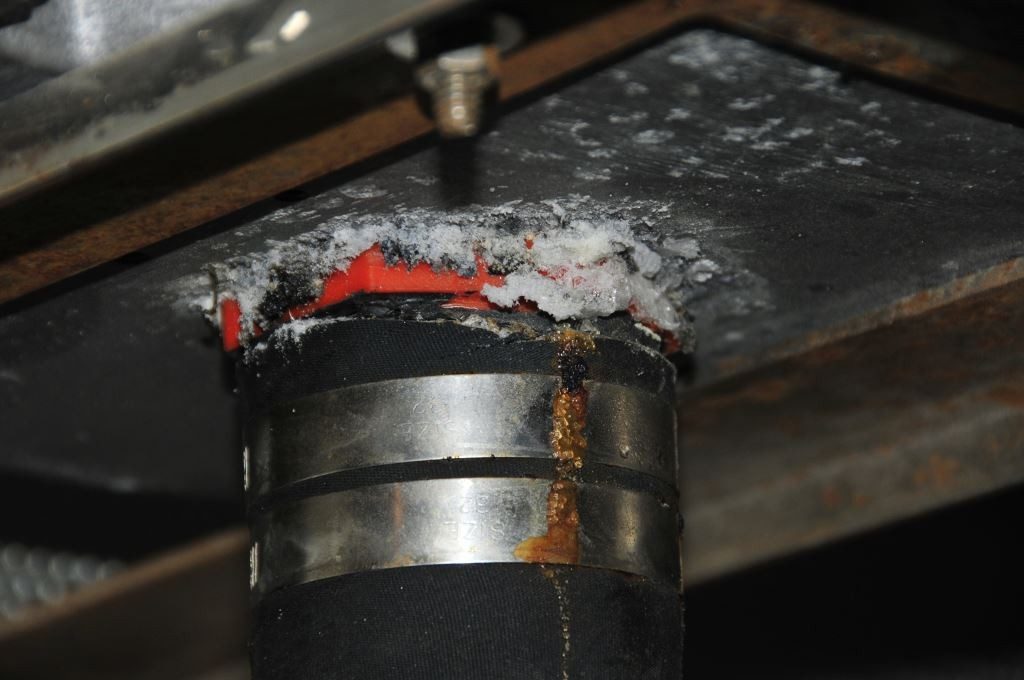
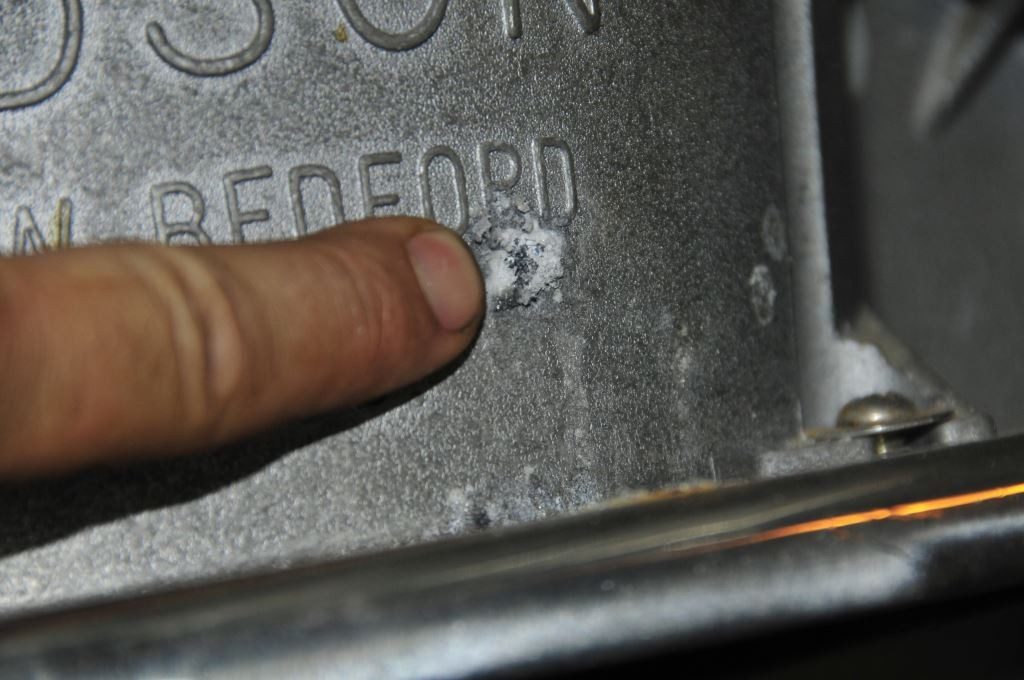
An aluminum body manual bilge pump. Stagnant water trapped inside this pump created a poultice corrosion chamber.
The most common conditions for poultice corrosion occur when stagnant water is trapped against aluminum, beneath blistered paint, under a gasket or insulator, beneath spreader boots, or even where it comes into contact with wood, which by its porous nature retains water. Poultice corrosion is prevented by ensuring aluminum is either continuously exposed to oxygen, or fully encapsulated. In the latter case, full and permanent encapsulation is virtually impossible.
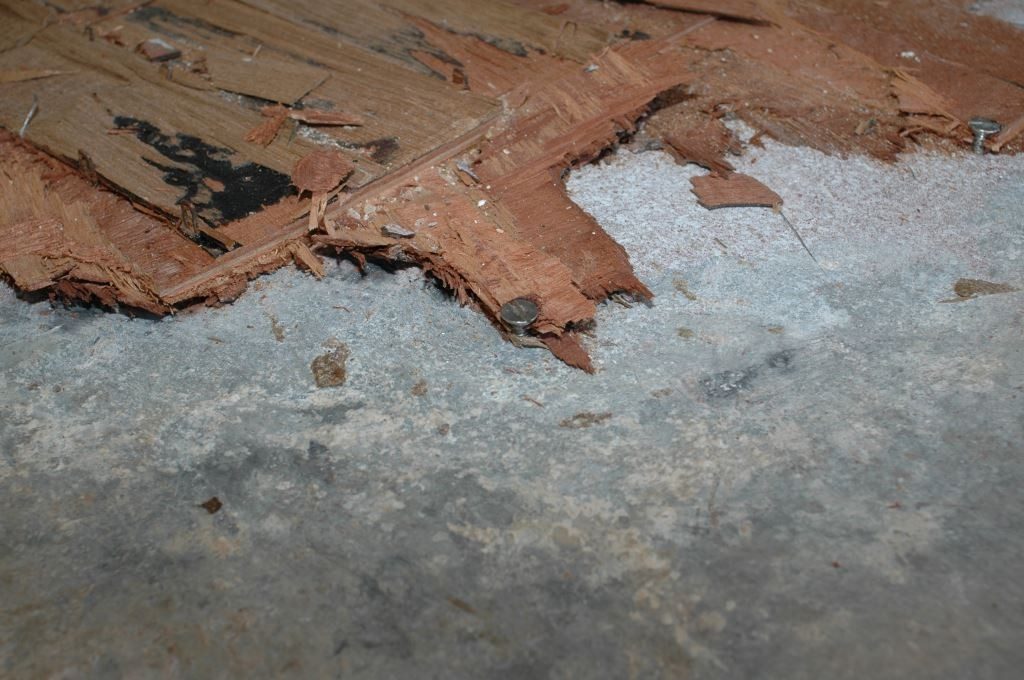
Teak over plywood over aluminum; it’s the ideal recipe for poultice corrosion. Hygroscopic materials, those that absorb water, should never be placed in direct contact with aluminum. The caveat includes aluminum tanks, water should never be allowed to be trapped against or under them. For more on this see TANKS
For instance, if painted, all that’s required for poultice corrosion to gain a toehold is a single nick or scratch that breaches the coating. Once the aluminum is exposed, the corrosion process begins. Among the most common causes of poultice corrosion involves the installation of hardware or fasteners over a painted aluminum surface, antennas, brackets, pad eyes, even a single screw head is enough to breach the paint. For more on dealing with and preventing this phenomenon see Paint and Aluminum.
Finally, aluminum, along with tin, lead and zinc, is an amphoteric metal, which means it is capable of reacting with an acid as well as a base. This makes aluminum susceptible to cathodic over-protection, i.e. using too many anodes. When aluminum is driven too negative, beyond -1200 mV, the alkaline solution produced at the cathode (the protected metal) can damage aluminum hulls, stern drives and other protected aluminum hardware, as well as causing hydrogen (which is produced at the anode) blistering of paint, also known as cathodic disbondment. Therefore, it is possible to under or over-protect aluminum, either of which can be harmful to the alloy itself or its coatings. Paint failure around through hulls, and other bonded underwater fittings, on fiberglass vessels is often a result of cathodic disbondment, which once again is caused by over-protection.
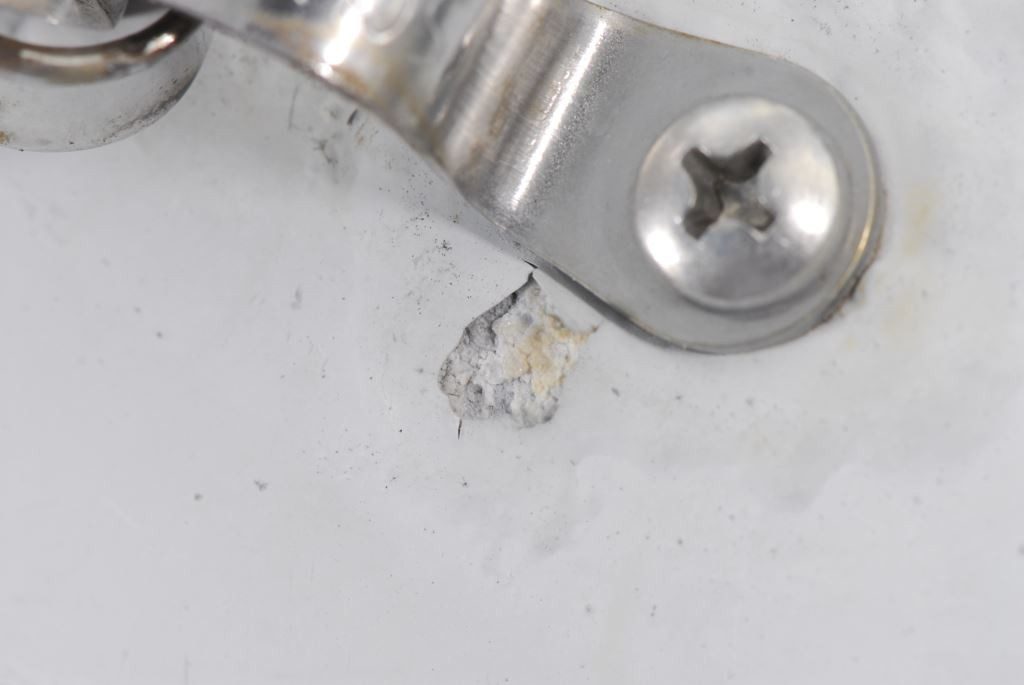
Breaches in coatings over aluminum painted substrate are most often caused by hardware installations. This failure mode can be prevented if the hardware is bedded in polyurethane or other sealant.
Aluminum is strong, versatile and corrosion resistant not corrosion-proof. If you understand its strengths, and more importantly its weaknesses, it’s likely to serve you well.